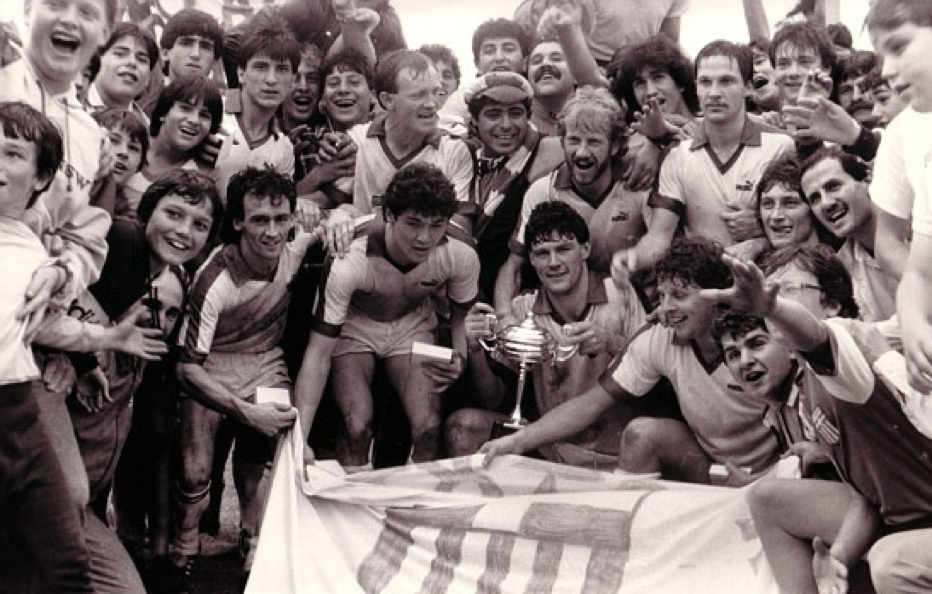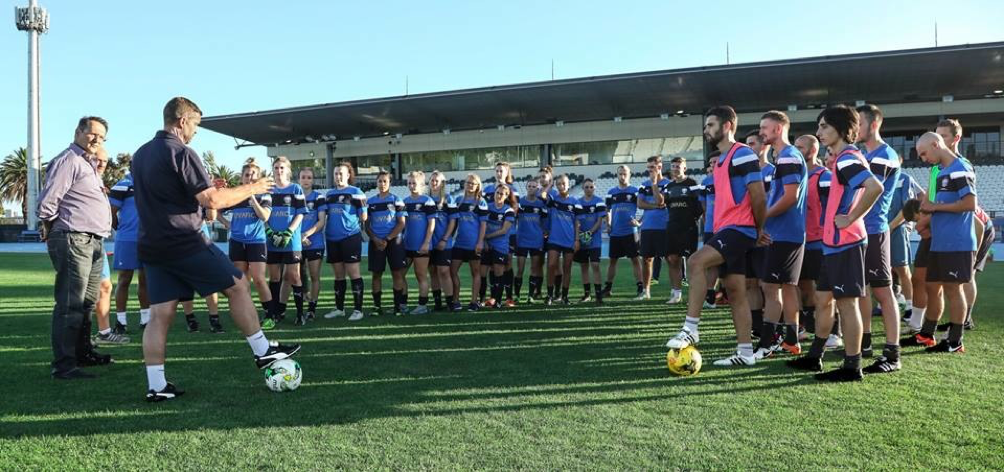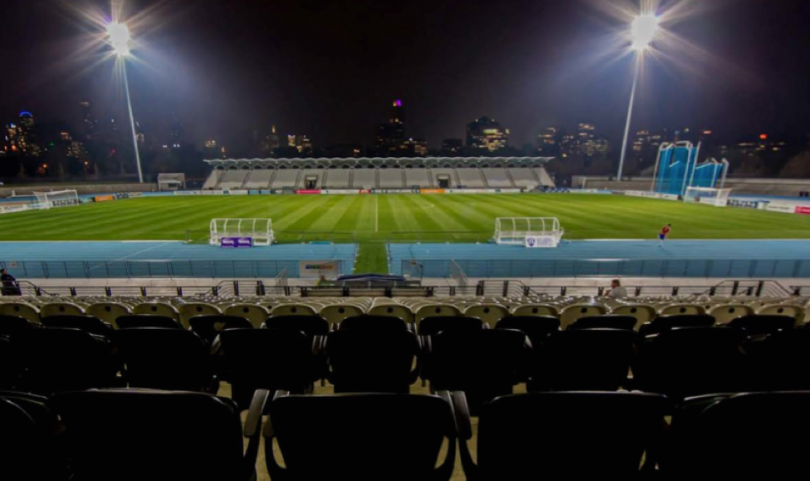There aren’t many state level sporting teams with a museum at their professional standard stadium, but South Melbourne Football Club isn’t your average club. At Lakeside Stadium, you’ll find troph y cases with enough silverware to rival the A-League’s best. A red pennant hangs in a glass cabinet, gifted to the club from English giants Manchester United after their match seventeen years ago. Mementos from four National Soccer League titles and ten Victorian championships take up their fair share of the display. But the trophy sitting almost directly centre in the museum is in many ways the most significant.
It’s not every club that’s awarded Oceanic Club of the Century, after all.
Yet that’s exactly what South Melbourne FC are. Their successes are many, their troubles now few. It would be easy to think that’s all they are; another club with a string of trophies and titles to their name. But this is a club with a history richer than most, a support stronger for their struggle, a passion and drive that many other teams couldn’t hold a candle to.
Now, they’ve got a new goal in their sights: the A-League.
“We’re really proud of our achievements,” says Leo Athanasakis, President of South Melbourne FC. “We’re very unique in the whole soccer landscape.”
Leo is full of pride as he walks through South Melbourne’s home at Lakeside Stadium. There’s not a single person we pass who Leo doesn’t greet, including the opposition players of the day who know him by name. They share some banter and, when they’re gone, Leo points out a wall running the length of the tunnel to the change rooms. He says they’re in the process of creating a Hall of Fame of sorts to decorate the blank space. He can’t quite stop himself from smiling as he adds the opposition will have to walk past this wall.
Leo has been South Melbourne’s president since 2007. He took over the reigns at what is commonly agreed to be the most dire period in South’s history following the demise of the National Soccer League at the end of the 2003/2004 season.
“When I took over, there was a lot of uncertainty,” says Leo. “We probably hit our lowest point as a club and the future wasn’t looking bright. We didn’t know where we were at and ultimately, we ended up back in the state league.”
The NSL was an important time for soccer in Australia and for South Melbourne in particular. The club won four championships throughout the NSL’s twenty-eight seasons, qualified for the 2000 FIFA Club World Championship in Brazil and cemented their reputation as formidable opponents on the soccer field. But in 2003, The Crawford Report — published following an investigation into the governance of soccer in Australia — found the NSL to be financially unviable. Enter: the A-League.
“We haven’t been resting on what we’ve done historically; it’s what we can deliver now.”
South Melbourne have been unable to compete in top-flight league football since the end of the NSL thirteen years ago. The club has been denied entry into the Hyundai A-League and Westfield W-League, the national senior soccer competitions for males and females respectively, by Football Federation Australia twice since their first bid in 2007. Fortunately, South Melbourne aren’t a club to dwell on their losses. They’re preparing to bid again.
“Ten years ago it was a resistance,” says Leo. He speaks frankly despite the hurt two unsuccessful A-League bids must cause the club’s current president. “It was all about defending our position. Slowly, we’ve chipped away at them and now everyone’s saying: ‘They should be in. It’s time.’ That rhetoric has changed in the past ten years because we’ve been listening. We haven’t been resting on what we’ve done historically; it’s what we can deliver now.”
What South Melbourne can deliver now is certainly a long way from their humble beginnings 56 years ago. At a time when many people were migrating to Victoria and soccer clubs were a common way to assimilate, local clubs Hellenic and Yarra Park amalgamated to form Hellas Soccer Club. In need of a ground, Hellas contacted Des and Bill Hamilton of British club South Melbourne United who had Middle Park, South Melbourne FC’s home prior to Lakeside. Recognising the advantage of teaming up with a club boasting thousands of Greek supporters, the Hamilton brothers agreed to amalgamate. In February of 1960, South Melbourne Hellas was born.
“It’s absolutely fair to say that the club was of huge importance to Greek migrants throughout the 1960s in particular,” says John Kyrou, Database Records Manager at South Melbourne FC. It’s clear the club’s history is a true source of pride for John and he assures me that once he starts talking about it, he’s not likely to stop. “The old Middle Park stadium was seen as a ‘home away from home’. Many Greek men cried when the final match was played there in 1994.”
But Leo is quick to point out that South Melbourne is not limited to one cultural group.
“It’s an Australian club that embraces everyone,” he says. “There’s no real mantra about, ‘You have to be Greek’. It’s just evolved from there. If you’re good enough, you play.”

South Melbourne celebrate their first NSL championship, 1984. (Source: SMFC)
Today, South Melbourne’s senior men face off against Pascoe Vale at Lakeside Stadium in the Victorian division of the National Premier Leagues. The stands are full of supporters of all ages and backgrounds, a sea of blue and white to cheer on the team. Someone has brought a drum and its steady beat assists the group singing at one end of the pitch. Families are scattered throughout the stands and an ever-growing group of elderly men watch on as twenty-two players take to the field. The crowd just witnessed South’s women’s team draw three-all against Green Gully. There’s a contagious suspense in the air, a subtle feeling coursing through the stands. It’s the desire to win that drives so many clubs to success and at South Melbourne, it’s an attitude 56 years in the making.
“The club’s rich history and heritage is a massive point of difference to the A-League franchises,” says John. “It should be one of South Melbourne’s strongest selling points in an A-League application. South Melbourne and all the traditional clubs are very important to Australian soccer. The club doesn’t have a divine right to be in the top flight of the game; however they, and other clubs like Melbourne Knights, deserve the opportunity to aspire to higher competitions than the NPL Victoria and the FFA Cup.”
“South Melbourne’s rich history and heritage is one of the club’s strongest selling points in an A-League application.”
It’s not just one of South Melbourne’s qualities that give them a competitive advantage in their upcoming A-League bid but a combination of many. The invaluable asset of a redeveloped stadium, a passionate support striving for national recognition and well-established mens, womens and juniors teams put South Melbourne in an enviable position to secure an A-League place. Always thinking one step ahead, the club has been in talks with soccer legend Roberto Carlos in regard to a coveted coaching position should South Melbourne return to top-flight football. It’s one of many ways South Melbourne is signalling to the soccer world that they mean business. With FFA involved in talks about expansion, it seems the governing body of soccer in Australia is listening.
“FFA is currently focused on developing a new operating and ownership model for the Hyundai A-League and Westfield W-League that facilitates expansion, grows asset values for existing and new club owners alike, and which supports the growth of soccer at all levels,” said an FFA spokesperson. “The interest from around Australia is welcome and shows the tremendous potential of the game.”

A joint training session for South Melbourne’s senior men and women. (Source: SMFC)
The significance of South Melbourne to Australian soccer cannot be understated. The national competition is young and lacking in history. South Melbourne brings a strong supporter base, a winning culture and decades worth of trophies, titles and legacies to the table in time for their third bid to join the A-League. They’ve listened and planned, amended and improved. They’ve waited for this day for thirteen years. Finally, it’s time.
South Melbourne defeated Pascoe Vale three-nil to the applause of their loyal supporters. Jean-Luke, a volunteer with no prior affiliation to the club, watched on with a smile. Costa, a past player with decades of involvement at South Melbourne, would’ve liked to have seen another goal. Leo Athanasakis, South Melbourne President and firm advocate for their A-League bid, walked through the stands with his head held high, simply one more fan happy to see the team he loves get a win.
“It’s not about who you were or what you were,” says Leo. He’s speaking of a club with fifty-two Socceroos, four national titles and the outstanding accolade of being named Oceanic Club of the Century. But South Melbourne aren’t resting on their past; they’re ready for the future.
“It’s about what you are and what you can be.”
Featured image: Lakeside Stadium: the home of South Melbourne FC. (Source: SMFC)

